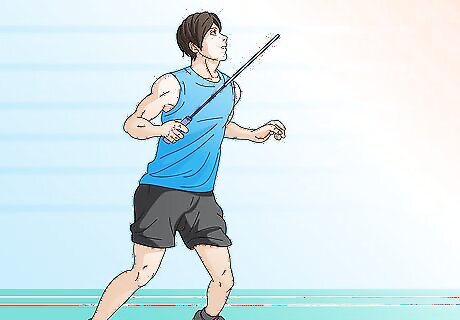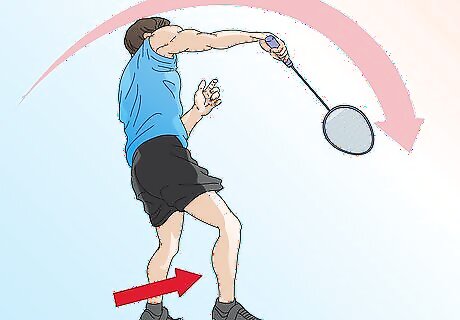
views
Forehand Smash

Approach the shuttlecock with a forehand grip. Be on your toes and ready to return the shuttle with a smash at any instant. You never know when a smash-worthy shot will present itself. When the shuttle is hit to your end of the court, get underneath and behind it as quickly as possible. The sooner you reach the spot where the shuttle appears to be incoming, the higher it will be and the more time you’ll have to set up a killer smash. You may hear serious badminton players call this kind of maneuver “injection of pace.” All this means is that you add a boost of speed so you have more time to react.

Assume a surefooted stance. If the shuttle comes in hot, you might not have a lot of time to react. In ideal conditions, both of your feet will be pointing to the side of the court. Your feet should be about shoulder width apart, your knees slightly bent, and your eyes tracking the ball. Balance is more important at this point than winding up for your smash. If you’re not well-balanced, it’ll negatively impact your smash.

Raise your arms and prepare to strike. Hold your racket upright and as far back as possible while still being comfortable. The arm of your non-racket hand should be bent at the elbow and the hand should be at about chin level. The fingers of your non-racket hand can be positioned however you like. Curling your fingers into a fist is most popular, but you can leave them spread out, too. As you prepare to strike, imagine the angle the shuttle will travel. It should be as steep downward as possible while still making it over the net. Raising your non-racket hand will act as a counterbalance for your racket hand, providing greater stability for your smash.

Strike the shuttlecock. Aim to connect with the shuttle at the highest point possible. Inhale deeply before you swing and stretch out your non-racket arm so it's roughly shoulder level. Swing with your full racket-arm and exhale as you do so. As you swing, your racket foot should shuffle forward. Power is important at this point, but even more important is hitting the shuttle with the center of the racket. When you feel the racket come in contact with the shuttle, snap your wrist downward. This will add power and steepness to the stroke. You can increase the power of your smash by contracting your abs at the same time you swing at the shuttle.

Follow through with your swing and recover for the next rally. An overhead smash will be much more difficult for your opponent(s) to return. But in the event they manage to get it back over the net, you’ll need to be ready to send it right back.
Jumping Smash

Get under and behind the shuttlecock quickly. Getting to the shuttle quickly is even more important for a jumping smash. If you move too slowly, the shuttle will be too low for you to get the most out of this swing. Hold the racket in a forehand grip on the approach. An overhead smash is very similar in the beginning to a regular smash: your body and feet should face side-court and your stance should be firm. The jumping smash will return the shuttle with greater power and at a steeper angle, making it even more difficult to return. Keep your body loose but ready. It’s common to tense your muscles when preparing to jump, but this can restrict your range of motion.

Prepare to jump. While keeping your eyes on the shuttle, stretch back your racket arm as far as you can. Your non-racket arm will be about level with your ribs and bent at the elbow. Bend a little at the knees and lean forward slightly. All set? Now you’re ready to jump.

Jump to intercept the shuttle at the highest point you can reach. Take a deep breath and drive downwards with your racket foot to jump into the air. Stretch out your non-racket arm so it’s above your head and off to your side to maintain balance while in the air. Timing is the key for a wicked jumping smash. In the best case scenario, you’ll be airborne and starting to swing at the highest point of your jump. When going into the jump, your legs should be mostly straight. As you reach the intercept point, bend your legs backwards.

Smash the shuttle over the net. Swing your racket forward to hit the shuttle and, as you do so, lower your non-racket arm to your side and straighten it at the elbow. Simultaneously, squeeze your abs as hard as you can and bring your racket foot forward a little. Envision a clear mental picture of the angle you want to send the shuttle on back over the net. This will help improve accuracy. If you have not started far enough behind the shuttle, or if you’re too far behind it, you won’t be able to fully extend your arm as you swing. This will decrease the power of your smash.

Follow through and stick the landing. Continue the motion of your swing after hitting the shuttle until your arm is facing forward and mostly straight. As you approach the ground, bring your racket foot farther forward so you’re ready to land. Stabilize after landing and be ready to return the shuttle. Jump smashes are most suitable on poor returns, where the shuttle is launched high toward the center of the court.
Backhand Smash

Choose your moment carefully. The backhand smash is an advanced, offensive strike that is one of the most difficult shots to return. The backhand smash is ideal for returns that send the shuttle high but relatively short. This shot gives your opponent little chance to react. Because this stroke is a little more difficult, make sure you’ve gotten the hang of the backhand stroke before attempting it. To perform a backhand smash, it’s especially important to be able to switch to a backhand grip quickly and naturally.

Position yourself to backhand smash. Get underneath and slightly behind the shuttle, as you would normally. Switch to a backhand grip and point your body at the back of the court. The faster you are able to switch your grip, the more power this smash will have. Opposite of most other smashes in badminton, to get the most devastating smash, you’ll need your racket arm as close to your body as possible. Much like other smashes, your non-racket arm should act as a counterbalance for your racket arm throughout this stroke. Check your grip and work on a fluid motion that begins at hip height and finishes at head height.

Crush the shuttle and get ready for the return. This should be a smooth, complete motion that extends through the point of contact until your arm is roughly straight. Upon contact, snap your wrist quickly in a flicking motion. Avoid gripping your racket too tightly for the best control. As your racket approaches the shuttle, imagine the angle that will take it over the net with as little clearance as possible. It’s very easy to lose your balance when performing the backhand smash. Remember to use your non-racket arm to stabilize yourself.



















Comments
0 comment